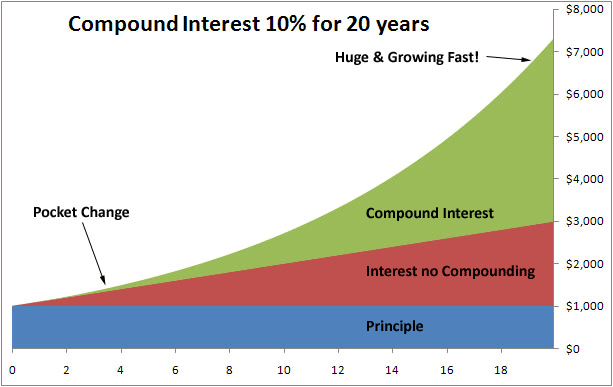Compound interest is the eighth wonder of the world. He who understands it, earns it … he who doesn’t … pays it. — Albert Einstein
James Hall, Contributor
Activist Post
Without a comprehensive understanding in this axiom of the financial universe, much of public policy and finance is incomprehensible. The different positions of the borrower and the lender is obvious, but the notion that one can earn enough interest on savings to maintain the purchasing power of the principal is a bygone fantasy in the era of low interest rates. Here is how compound interest works for the depositor.
An amount of $1,500.00 is deposited in a bank paying an annual interest rate of 4.3%, compounded quarterly. What is the balance after 6 years?
The balance after 6 years is approximately $1,938.84.
Contrast the difference between being the lender to that of the debtor and you get a very different result.
A Dr. Cabler provides this account.
If someone came up to you on the street and said they would give you a crisp, new $20 bill, and the only stipulation is that you give them back $40 tomorrow, you’d probably tell them just what they could do with that $20 bill.
Anyone you ask would say that’s a bad deal, but when you demonstrate that borrowing money by using credit cards and consumer debt is exactly the same thing, these same people (who are in debt) give a puzzled look, and for some a light turns on and they begin to understand. But for others, they just refuse to see that debt, and the compound interest that comes with it is a major drag on your finances and ends up making your poorer ever single time.
Therefore, the simple distinction between earning next to zero interest on your bank deposits, while paying usury rates on your consumer debt charge cards or lines of credit, is a guaranteed formula for personal bankruptcy.
Now deepen this dilemma with the insights learned from the national Ron Paul effort to educate the public on the horrors of the privately owned Federal Reserve System. Eric Padden clarifies the sham that underpins the monetary fraud that enslaves the entire planet, in Inflation explained – Dollar Bubble – Government Debt Bubble.
Most people do not understand that we don’t just print the money via the Fed. We borrow it at interest and it is that compounding interest that is the root cause of the enormous government debt bubble we have today.
The most frustrating part of this to me is that it is completely unnecessary. Our currency should simply be created through our treasury as described in our Constitution without interest. In this way we could pay off our deficit in no time and build a healthy economy.
Ever since the Fed ( a private banking cartel with its roots in Europe ) hijacked our economy in 1913 the dollar has lost 98% of its purchasing power due to the constant, systematic increase in our money supply. Ever increasing inflation is the only possible result of the Fed’s monetary policy.
 This simple and accurate explanation goes unknown to the average indebted serf who is desperately carving out a meager existence. This strangle hold burden built upon debt created fiat money is an engineered system of theft and subjugation.
This simple and accurate explanation goes unknown to the average indebted serf who is desperately carving out a meager existence. This strangle hold burden built upon debt created fiat money is an engineered system of theft and subjugation.
The obligation bubble that grows exponentially without any prospects of paying the interest without the infusion of higher levels of new Federal Reserve debt is the fundamental mechanism that guarantees an ultimate default.
The eternal debate is between the natural deflationary forces seeking to cleanse the excessive leverage and the hyperinflation urges to keep infusing the next fix of liquidity to band-aid a terminal Ponzi scheme of larceny.
In either case, the underpinning objective is to get out of paper debt obligations or claims on loans that can no longer be serviced.
Transferring out of accounting ledger entries into solid assets requires a foreclosure on the entire financial debtor economy. Do not be fooled that a recovery is possible. Rational people intuitively struggle to pay off or down their debt. However, the dramatic forces of fractional reserve banking provide the financial power to throw the system into receivership. Michael Hudson in Productivity, The Miracle of Compound Interest and Poverty, makes a case why the poor always gets poorer.
And indeed today, markets are shrinking in many countries. But not because people are saving out of prosperity. The jump in reported ‘saving’ in the National Income and Product Accounts (NIPA) in recent years has resulted from repaying debts. It is a negation of a negation – and hence, a statistical ‘positive.’
Paying off a debt is not the same as building up liquid savings in a bank. It reflects something that only a very few economists have worried about over the past century: the prospect of debts rising faster than income, leading to financial crashes that transfer property from debtors to creditors, and indeed polarize society between what the Occupy Wall Street movement calls the 1% and the 99%.
‘Wealth creation’ by debt leveraging – that is, asset-price inflation – was celebrated as a post-industrial economy, as if this were a positive and natural evolution. But in reality it is a lapse back into a rentier economy, and even into a kind of neofeudalism. The post-2008 bailouts have vested a new rentier elite to lord it over the 21st century, thanks to the fact that most gains since 1980 have gone to the 1% – mainly the financial sector, not to the 99%.
This is not simply a class struggle equation that blames the much-maligned 1%. The basic banking racket is the cause of the continuous bust cycles. During each of these designed implosions, the international banksters consolidate their control over the finances of their indentured customers.
As the final bubble approaches, an eruption of volcanic propositions is poised to realign the entire monetary structure of world commerce. Face facts, the banks are ready to foreclose on the assets they do not already dominate.
Original article archived here
James Hall is a reformed, former political operative. This pundit’s formal instruction in History, Philosophy and Political Science served as training for activism, on the staff of several politicians and in many campaigns. A believer in authentic Public Service, independent business interests were pursued in the private sector. Speculation in markets, and international business investments, allowed for extensive travel and a world view for commerce. Hall is the publisher of BREAKING ALL THE RULES. Contact batr@batr.org
You can support this information by voting on Reddit HERE
linkwithin_text=’Related Articles:’



Be the first to comment on "Compound Interest and the Debt Bubble"